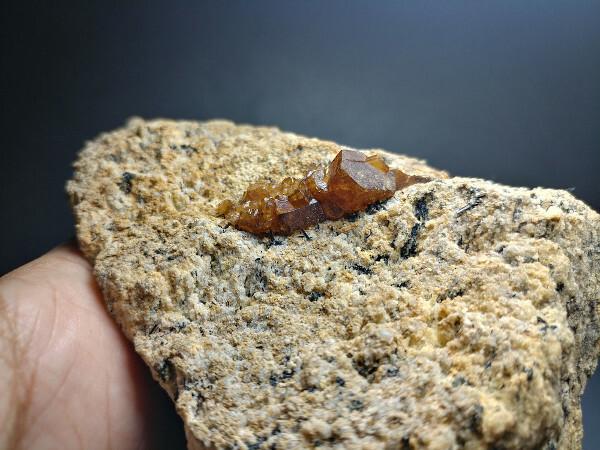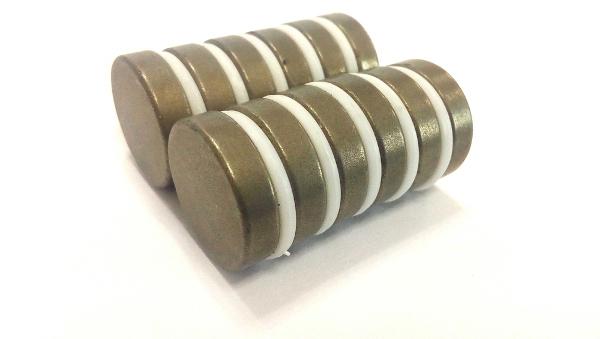O samariumit is a chemical element belonging to the group of lanthanides, also known as rare-earth metals. Samarium has the classic +3 oxidation state of the lanthanides, but it also has the stable +2 oxidation state. It has good resistance to corrosion, as its metallic form produces a layer that protects it from deeper corrosive processes.
In its metallic form, it is obtained via reduction with lanthanum, at high temperatures, in a discontinuous industrial process lasting approximately ten hours. Samarium is mainly used in the production of permanent magnets, in the form of an alloy of samarium and cobalt, SmCo. AND a magnet that maintains its magnetic properties at good temperatures, is affordable and resistant to corrosion. It is also applied as neutron control rods in nuclear reactors.
Read too: Chromium — another chemical element known for its good corrosion resistance
Topics of this article
- 1 - Summary about samarium
- 2 - Properties of samarium
- 3 - Characteristics of samarium
- 4 - Where can samarium be found?
- 5 - Obtaining samarium
- 6 - Applications of samarium
- 7 - History of samarium
Summary on Samarium
Samarium, symbol Sm and atomic number 62, is a metal belonging to the lanthanides, also known as rare-earth metals.
Like the other lanthanides, it has an oxidation state of +3 in compounds, but it also has a stable state of +2.
It has good corrosion resistance.
It is mainly found in monazite and bastnasite.
Its metallic form is produced via reduction with lanthanum.
It is mainly used for the production of permanent magnets when it forms metallic alloys with cobalt.
Do not stop now... There's more after the publicity ;)
Samarium properties
Symbol: sm.
Atomic number: 62.
Atomic mass: 150.36 a.u.a.u.
Electronegativity: 1,17.
Fusion point: 1072 °C.
Boiling point: 1794 °C.
Density: 7.520 g.cm-3 (α form, 25 °C).
Electronic configuration: [Xe] 6s2 4f6.
chemical series: rare earth metals, lanthanides.
Characteristics of samarium

samarium is one of the metallic elements belonging to the lanthanide series, also known as rare earth metals. Like the other metals in this group, samarium is a soft, white metal. However, such metals are commonly covered by a thin oxide layer that protects them from more severe oxidative processes.
Like all other lanthanides, Sm has the oxidation state +3 in solution. What sets it apart, however, is the oxidation state +2 well defined, something it only shares with the elements ytterbium (Yb) and europium (Eu) of this series.
When in contact with dilute acids or steam, samarium releases H gas2, in addition to forming the oxide Sm2O3 when burned in the presence of atmospheric air. When heated, samarium can react with H2 and form hydrides such as SmH2 and the SmH3. Samarium carbides can also be formed when this element is heated with carbon, forming Sm2W3 and the SmC2.
Natural samarium is composed of seven isotopes, two of which are unstable, the 147sm and the 148sm. However, their half-lives are very long, being 1.06 x 1011 years and 7 x 1015 years, respectively.
Where can samarium be found?

All lanthanides, with the exception of promethium (Pm), are found in nature in two minerals, mainly bastnasite, a mixture of rare-earth carbonate fluorides, and the monazite, a rare-earth phosphate.
Still, it is possible to find samarium in other minerals, such as fergusonite (an oxide that mixes light and heavy rare-earths, actinides and other metals), the xenothyme (a yttrium phosphate) and the eudialite (a silicate of several metals that has light and heavy rare earths in its composition).
Obtaining samarium
Samarium compounds, such as its oxides, phosphates and fluorides, can be obtained from samarium mineral sources. Mineral cracking and preparation mining techniques are used, until it undergoes leaching acid, purification and separation of compounds, either by selective crystallization, ion exchange or extraction by solvent.
However, to obtain pure metallic samarium, whose applications are more explored, another technique is necessary: its reduction.
A samarium reduction occurs by another rare-earth metal, lanthanum (La). Samarium is produced in the form of a vapor, and the reaction takes place at a temperature of 1200 °C:
sm2O3 (s) + 2 La (l) → La2O3 (s) + 2 Sm (g)
This reaction also takes place inside a vacuum chamber, with pressure in the range of 10-3 to 10-4 Pascals. The recovery rate of samarium from its oxide is in the range of 90%. The process takes place in batches, with an average duration of ten hours, and produces from 20 to 40 kg of metallic samarium. An industrial plant can produce up to 100 kg of samarium vapor per day.
Samarium applications
The main application of samarium is in the production of permanent magnets.. This is achieved when he forms the alloy with the cobalt (Co), whose crystalline forms are SmCo5 and Sm2co17. It stands out for its low price and for its great resistance to high temperatures, that is, it maintains its properties stable magnetic properties even at temperatures in the range of 150 °C, necessary for application in motors and power generators. energy.
This puts it ahead of its main competitor, NdFeB permanent magnets (which have been gaining more attention lately), which need to replace neodymium (Nd) atoms with dysprosium (Dy) or terbium (Tb) to have greater thermal resistance, which increases their price Final. Furthermore, SmCo magnets are more resistant to corrosion.

The samarium It is also applied as a control rod in nuclear reactors. (devices that control the energy released in a fission), since its isotope 149Sm has a great affinity for neutrons. This assists in the kinetic control of nuclear reactions, controlling the energy produced in nuclear plants.
See too: Strontium — another chemical element used in the production of magnets
history of samarium
In the Russian mountains Ilmen, two minerals were discovered from which several rare earths were discovered: monazite and samarskite. This was first described in 1839 by the German mineralogist Gustav Rose.
He found uranium and tantalum in the composition of samarskite and thus proposed the name uranotantalite. Gustav's brother, the chemist Heinrich Rose, did an independent analysis in 1844 and found that much of the mineral was, in fact, composed of niobium, coining the name for this metal that, at the time, was called columbium. To differentiate the name of the metal and the composition of the mineral, Heirinch decided to rename the mineral “samarskite”, in honor of Colonel Samarksy-Bykhovets, who provided him with samples.
Large amounts of the mineral samarskite were found in North America in 1878, making it a starting material for isolating new rare-earth elements. Lecoq de Boisbaudran isolated, in 1879, a new metallic oxide from the mineral samarskite, proposing the name samarium., maintaining the etymology of the mineral samarskite.
By Stefano Araujo Novais
Chemistry teacher
Have you ever heard of the chemical element cerium? Click here and learn about its characteristics, properties, applications, obtaining and history.
Learn about the particularities of the internal transition elements (actinides and lanthanides), which occupy the sixth and seventh period of group 3 of the Periodic Table.
Learn more about scandium, as well as its characteristics, properties, applications, obtainment and its history.
Click here and learn more about iterbium. Learn about its characteristics, properties, applications, obtaining and history.
Have you ever heard of the chemical element lutetium? Click here and learn about its characteristics, properties, obtaining, applications and history.
Have you ever heard of the chemical element yttrium? Click here and learn about its characteristics, properties, applications, obtaining and history.

